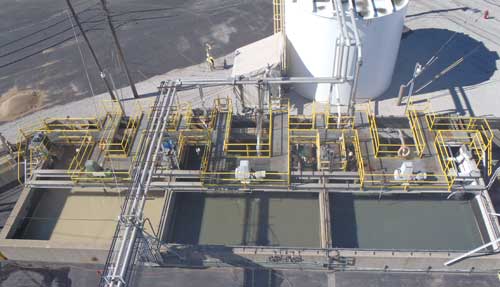Preliminary Treatment
Barscreens
 PC-Preliminary-Details-1-web.jpgThere are two sets of barscreens filtering the wastewater when it enters the PChem influent pump station. The first set is angled to enable manual raking of the screens. The bars are set an inch and a quarter apart to filter out larger trash and debris.
PC-Preliminary-Details-1-web.jpgThere are two sets of barscreens filtering the wastewater when it enters the PChem influent pump station. The first set is angled to enable manual raking of the screens. The bars are set an inch and a quarter apart to filter out larger trash and debris.
The second set of barscreens are located just before the pumps. At times of extremely high flow, some trash and debris may get past the initial set of barscreens. The second set is in place to keep the trash and debris out of the pumps.

Oil Skimmers
 PC-Preliminary-Details-4-web.jpgThere are a total of nine oil skimmers in the south wetwell: two belt skimmers and seven rope skimmers. The belts and ropes are made of an oil attracting material. They float on the top of the water and rotate through a belt press located above the water. As the material skims across the top of the water, it picks up oil. The belt or rope is then squeezed through a press to remove the oil into a skimmer trough. The oil is pumped to the one of two oil storage tanks. The oil is decanted to remove excess water prior to disposal.
PC-Preliminary-Details-4-web.jpgThere are a total of nine oil skimmers in the south wetwell: two belt skimmers and seven rope skimmers. The belts and ropes are made of an oil attracting material. They float on the top of the water and rotate through a belt press located above the water. As the material skims across the top of the water, it picks up oil. The belt or rope is then squeezed through a press to remove the oil into a skimmer trough. The oil is pumped to the one of two oil storage tanks. The oil is decanted to remove excess water prior to disposal.


Neutralizers
 The final stage of preliminary treatment is the neutralization process. Due to the extremely low pH of the influent wastewater, large quantities of lime must be added to achieve the optimum pH level of 8.3. An average of 248 dry tons of lime per month is used at the PChem treatment facility.
The final stage of preliminary treatment is the neutralization process. Due to the extremely low pH of the influent wastewater, large quantities of lime must be added to achieve the optimum pH level of 8.3. An average of 248 dry tons of lime per month is used at the PChem treatment facility.
 Slaked lime is pumped from the lime slurry storage tank to each of the three neutralizer tanks. As the lime is added, mixers in each tank ensure thorough mixing of the wastewater and the lime slurry. The pH rises from around 2.0 to 8.3 by the time the wastewater has left the third neutralizer tank.
Slaked lime is pumped from the lime slurry storage tank to each of the three neutralizer tanks. As the lime is added, mixers in each tank ensure thorough mixing of the wastewater and the lime slurry. The pH rises from around 2.0 to 8.3 by the time the wastewater has left the third neutralizer tank.
Neutralizing the wastewater ensures that it is no longer corrosive. This protects the equipment further down the treatment process. The addition of lime and the increase of pH will also allow the dissolved metals in the wastewater to precipitate out in the clarifiers. The metals and acidity of the wastewater could potentially affect the biological process at American Bottoms if the wastewater is not neutralized.

